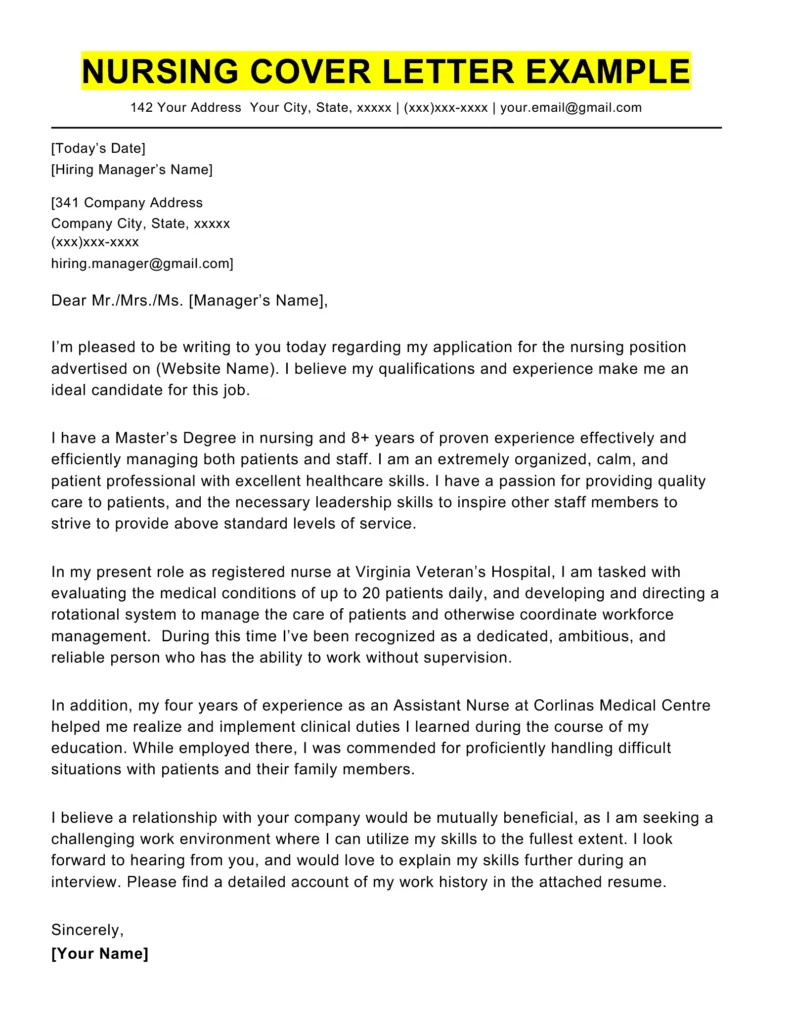What is a Nursing Cover Letter?
A nursing cover letter is a crucial document that accompanies your nursing resume when applying for a job. It serves as an introduction to your skills, experience, and qualifications, allowing you to showcase your personality and express your interest in a specific position. Unlike a resume, which is a concise summary of your professional history, a cover letter provides an opportunity to expand on your accomplishments and explain why you are the perfect fit for the role and the healthcare facility or organization. It’s your chance to make a strong first impression and demonstrate your enthusiasm for the opportunity. The goal is to persuade the hiring manager to read your resume and ultimately invite you for an interview, so it is crucial to craft a compelling and well-written cover letter that stands out from the competition. Remember, a well-crafted nursing cover letter can significantly increase your chances of getting hired.
Why You Need a Nursing Cover Letter
In the competitive field of nursing, a cover letter is not just an optional add-on; it’s an essential component of your job application. It gives you an advantage by allowing you to personalize your application and demonstrate your understanding of the specific needs of the employer. It helps to bridge the gap between your resume and the job requirements. A cover letter provides the space to elaborate on your experiences and showcase your skills and passion in ways that a resume cannot. It allows you to explain your career aspirations, describe why you are interested in the particular opportunity, and highlight your relevant skills and achievements with specific examples. Moreover, a well-written cover letter reflects your communication skills, attention to detail, and professionalism, making a positive impression on potential employers. Including a cover letter allows you to express your personality and demonstrate why you’re the ideal candidate, setting you apart from other applicants.
Key Components of a Nursing Cover Letter
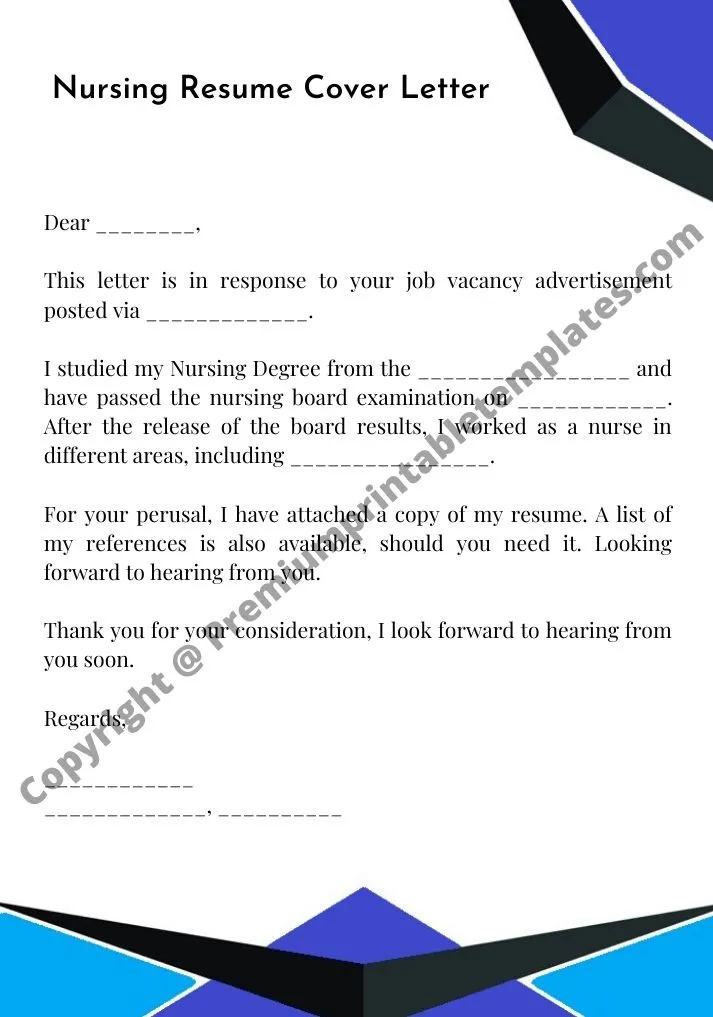
A well-structured nursing cover letter typically includes several key components, each serving a specific purpose in presenting your qualifications and expressing your interest. These components work together to create a compelling narrative that captures the hiring manager’s attention and encourages them to learn more about you. Let’s delve into the essential elements to create a cover letter that effectively highlights your strengths and makes you stand out. Understanding these elements is the foundation of creating a cover letter that is both informative and persuasive. By mastering these components, you increase your chances of securing an interview and advancing your nursing career.
Header and Contact Information
The header of your nursing cover letter should include your full name, address, phone number, and professional email address. Ensure this information is accurate and up-to-date. This is the first thing the hiring manager will see, so it’s important to make a professional impression right from the start. It allows the reader to quickly identify you and find the best ways to contact you. Consider using a professional font and formatting to maintain a polished look. This section provides an easy and convenient way for the employer to reach you if they want to move forward with your application. Double-check all the details to avoid any errors.
Greeting and Introduction
Start your cover letter with a professional greeting, such as “Dear Hiring Manager” or, if possible, the name of the individual you are addressing. The introduction should immediately capture the reader’s attention by stating the position you’re applying for and briefly mentioning how you learned about the opportunity. This helps establish the purpose of your letter right away and shows that you have a clear understanding of the role you are seeking. It’s also important to mention your years of experience or any special certifications or licenses you possess. This sets the stage for the rest of your cover letter and gives the hiring manager a snapshot of your suitability for the role. Make your introduction concise, enthusiastic, and specific to the job.
Body Paragraphs
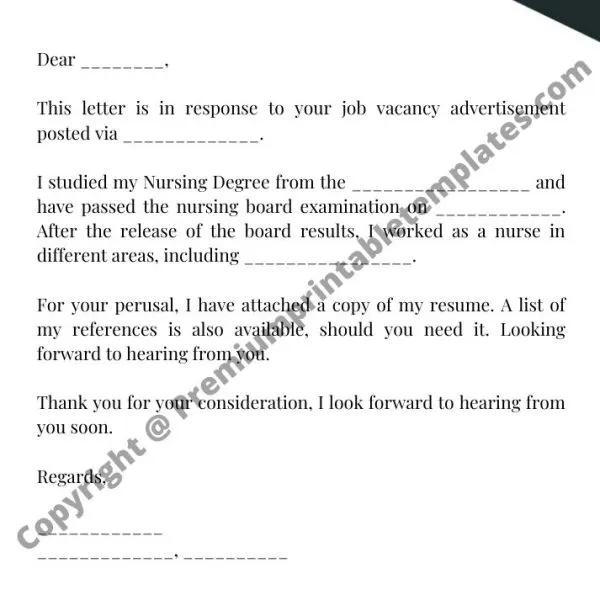
The body paragraphs are the core of your cover letter, where you elaborate on your skills, experience, and qualifications. These paragraphs should highlight your accomplishments and explain how they align with the requirements of the job description. Use specific examples to demonstrate your abilities, such as successful patient outcomes or positive feedback from supervisors. This allows you to showcase your competence and illustrate your potential value to the employer. Tailor each paragraph to the specific job and company to show your genuine interest. Always focus on what you can bring to the role and how you can contribute to the healthcare facility’s goals. This personalized approach significantly increases the chances of your cover letter making a favorable impression on the hiring manager.
Highlighting Skills and Experience
In the body of your nursing cover letter, you should highlight the skills and experiences most relevant to the job. Review the job description carefully and identify the key requirements and qualifications the employer is seeking. Then, provide specific examples from your work history that demonstrate how you possess those skills. This might include patient care, communication, critical thinking, or leadership skills. The goal is to show the hiring manager how your unique abilities and past achievements align with the demands of the position. Use action verbs to describe your accomplishments, such as “managed,” “coordinated,” or “implemented.” By providing detailed evidence of your competencies, you prove that you are a suitable candidate for the role.
Quantifying Achievements
Quantifying your achievements is a powerful way to demonstrate the impact you’ve made in previous roles. Instead of simply stating that you improved patient outcomes, provide specific numbers or statistics to support your claim. For example, you might say that you “reduced patient falls by 15% through the implementation of a new fall prevention program.” This provides concrete evidence of your effectiveness and allows the employer to see the value you can bring to their organization. Always try to back up your claims with measurable results. If you can, include details like the number of patients you’ve cared for, the positive feedback you received, or improvements you made in efficiency. Numbers bring your achievements to life and significantly boost the credibility of your cover letter.
Tailoring to the Specific Job
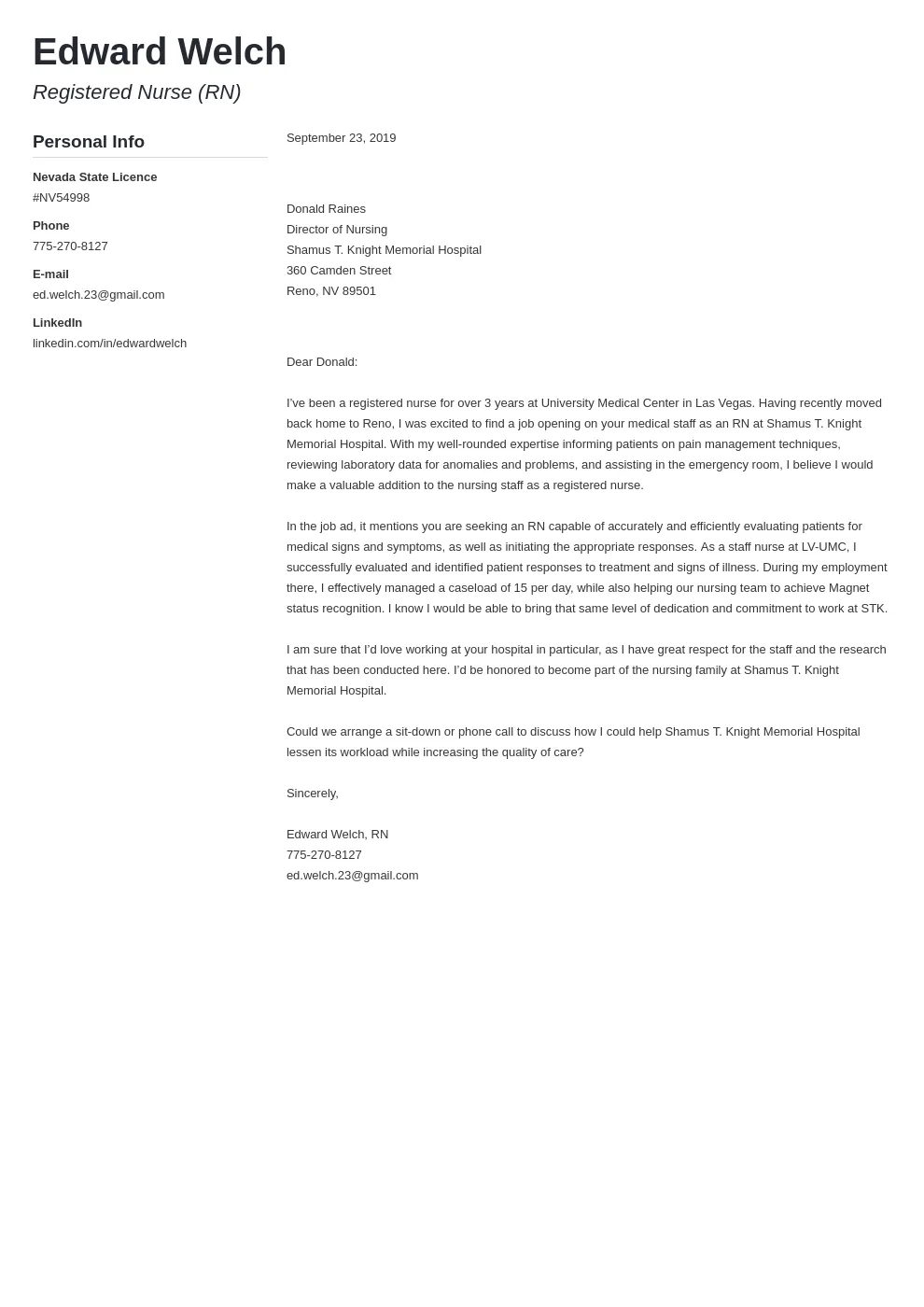
A generic cover letter won’t make a lasting impression. Tailoring your cover letter to the specific job and the healthcare facility or organization is essential to show that you’ve done your research and are genuinely interested in the opportunity. Review the job description carefully and identify the key requirements, skills, and values the employer is looking for. Then, in your cover letter, explicitly address these requirements, highlighting how your experience and qualifications align with their needs. You might also mention your understanding of the organization’s mission or any specific programs or initiatives that resonate with you. This personalized approach shows that you’ve taken the time to understand the role and the employer, making your application more compelling.
Call to Action and Closing
Conclude your cover letter with a clear call to action. Express your eagerness to discuss your qualifications further and thank the hiring manager for their time and consideration. Make sure you let them know that you are available for an interview and provide your contact information. A strong call to action encourages the reader to take the next step and shows your enthusiasm for the opportunity. Always end with a professional closing, such as “Sincerely” or “Best regards,” followed by your typed name. Proofread your entire letter carefully before submitting it to ensure there are no errors.
Formatting and Presentation
The formatting and presentation of your nursing cover letter are essential to creating a positive first impression. Use a professional and easy-to-read font, such as Times New Roman or Arial, with a font size of 11 or 12 points. Ensure that your letter is well-organized, with clear headings, concise paragraphs, and ample white space. This helps the reader to easily scan the document and grasp the key points. Use a standard business letter format and keep the letter to one page in length. A clean and well-formatted cover letter reflects your attention to detail and professionalism. Ensure your cover letter looks polished and professional, making a great impression on the hiring manager. Remember that a visually appealing cover letter increases the likelihood of it being read and considered.
Proofreading and Editing
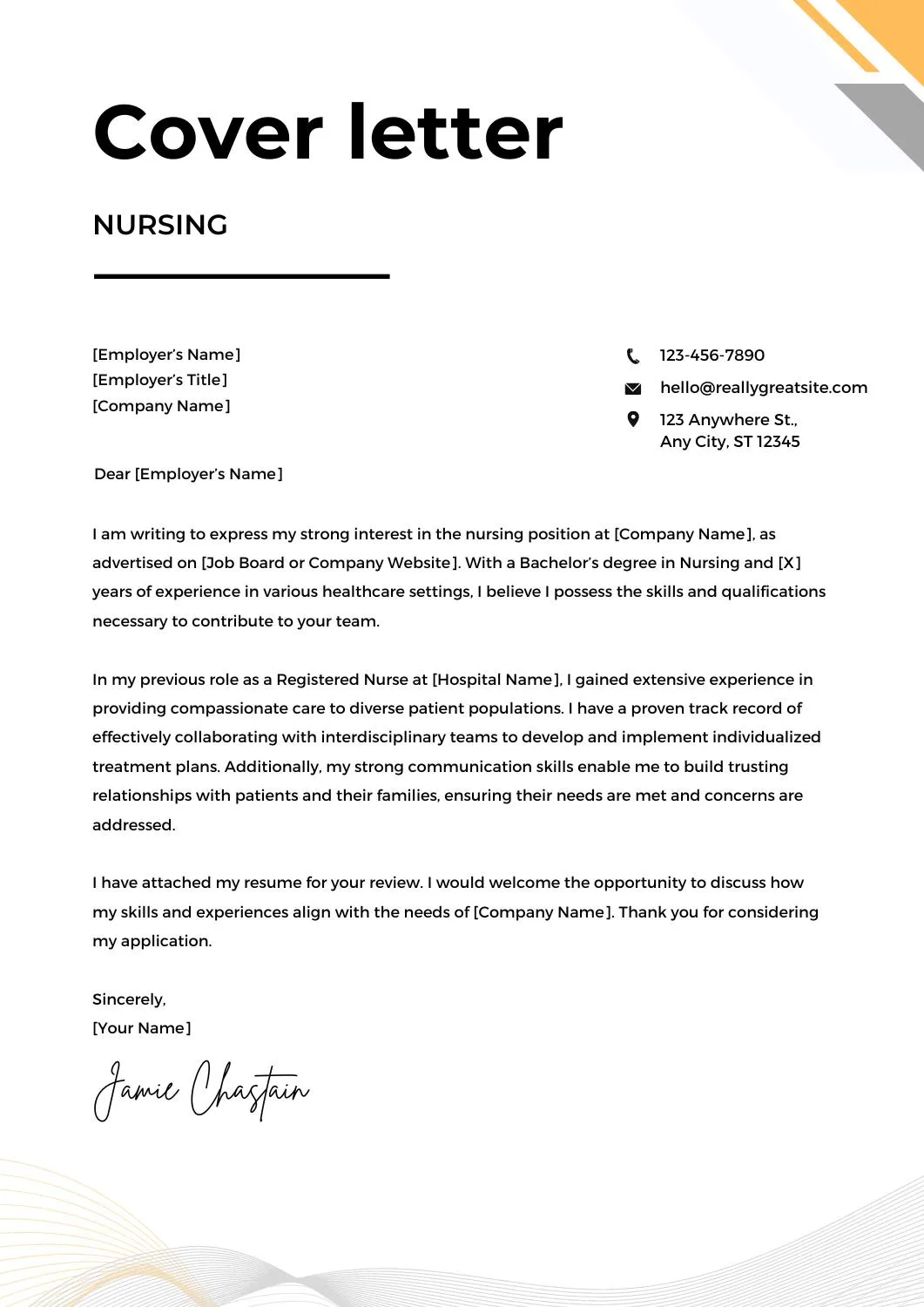
Before submitting your nursing cover letter, meticulous proofreading and editing are crucial to ensure that it is free from any errors. Typos, grammatical errors, and inconsistencies can undermine your credibility and make a negative impression on the hiring manager. Take the time to carefully review your letter for any mistakes, paying close attention to spelling, grammar, punctuation, and sentence structure. Use a spell checker and grammar checker as a helpful tool. It’s also beneficial to have another person review your cover letter for any mistakes that you may have missed. A fresh pair of eyes can often spot errors that you may have overlooked. By carefully proofreading and editing your cover letter, you’ll demonstrate your attention to detail and commitment to excellence, making your application stand out.
Tips for Writing an Effective Nursing Cover Letter
Writing an effective nursing cover letter involves much more than just listing your skills and experience. Here are some additional tips to help you create a compelling letter that captures the attention of hiring managers and highlights your value. By following these guidelines, you will be able to demonstrate your professionalism and the specific ways you can contribute to the nursing team and the facility’s overall goals. An effective nursing cover letter is the key to impressing potential employers. By implementing the advice, you can showcase your qualities and boost your chances of getting hired for the nursing role you want.
Use Keywords
Incorporate relevant keywords from the job description throughout your cover letter. This practice not only helps demonstrate that you’re a good fit for the position but also improves the chances of your application being noticed by applicant tracking systems (ATS). Analyze the job posting and identify the key skills, qualifications, and terms used by the employer. Then, strategically weave these keywords into your introduction, body paragraphs, and closing. Using the right keywords shows that you have a clear understanding of the role and that your qualifications align with the employer’s needs. Make sure that your keywords are used in a natural and relevant manner, not keyword stuffing, so the document remains readable and engaging.
Show Enthusiasm
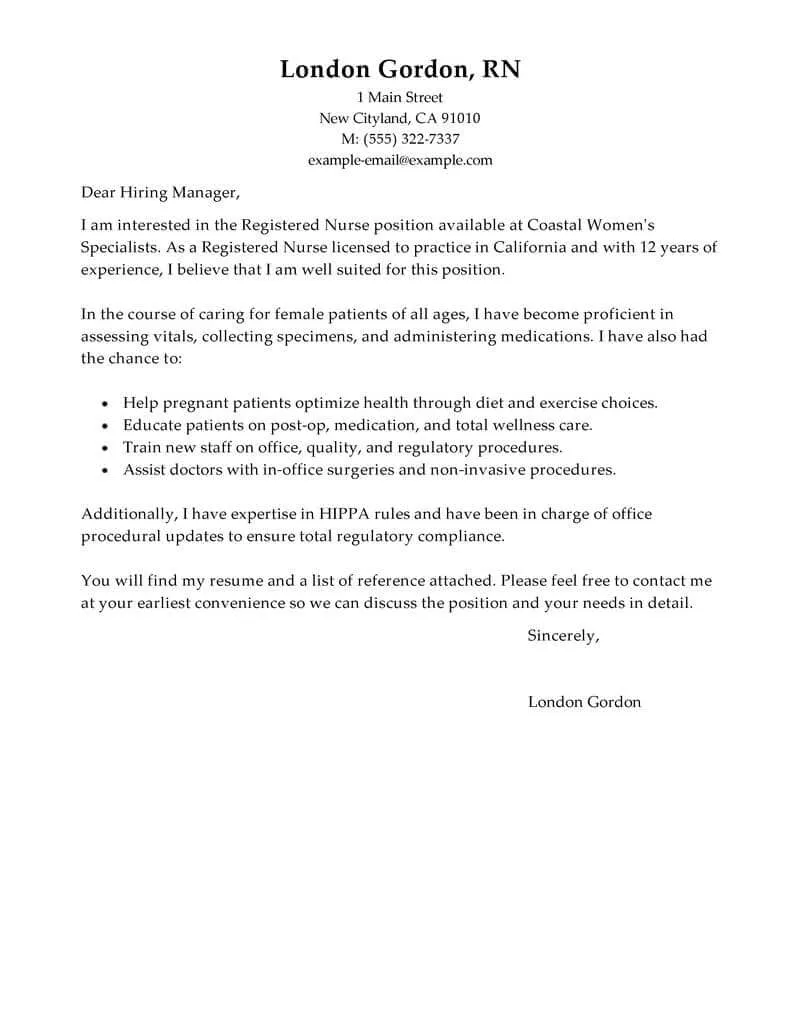
Express your enthusiasm for the nursing position and the organization. Show that you are truly excited about the opportunity by using passionate language and highlighting your genuine interest in the work. This can be reflected in your word choice and the tone of your writing, which makes you more appealing to potential employers. Explain why you are interested in the specific role and how your goals align with the healthcare facility’s mission and values. Demonstrate a clear understanding of the healthcare facility and the contributions you can make. Your enthusiasm will set you apart from other applicants and make you more memorable. It’s important to be genuine and let your personality shine through to show that you are a great fit for the role and the team.
Highlight Relevant Experience
Focus on the experiences and skills that are most relevant to the specific job you are applying for. Tailor your cover letter to show how your past experiences have prepared you for the role and how you will contribute to the healthcare facility. This might include experience in a particular area of nursing, such as critical care or pediatrics, or it might involve demonstrating specific skills like patient communication, leadership, or teamwork. Avoid simply listing your entire work history. Instead, select the most relevant accomplishments and explain how they align with the employer’s needs. Provide examples that prove how you’ve used those skills to benefit patients or achieve goals. By emphasizing relevant experiences, you increase your chances of making a strong impression.
Proofread Carefully
As mentioned before, always proofread your cover letter meticulously before submitting it. Ensure your writing is free of grammatical errors, spelling mistakes, and typos. Errors can undermine your credibility and professionalism, so it’s essential to catch them. Even small mistakes can give employers the impression that you lack attention to detail or haven’t put in the effort required to create a polished application. Read the letter aloud to yourself, as this can help you identify awkward phrasing or any sections that do not flow well. Consider having someone else review your cover letter to provide a fresh perspective and catch any mistakes you might have missed. Proofreading is a key step in showing your ability to communicate professionally and it can give you a great advantage over the competition.
Nursing Cover Letter Examples
Reviewing nursing cover letter examples can provide valuable insights into effective writing techniques and formatting. These examples offer guidance on how to structure your letter, highlight your qualifications, and tailor your message to specific job requirements. Use these samples as inspiration and adapt them to your unique background and career goals. They can help you better understand how to present your experiences, skills, and enthusiasm in a professional and compelling way. It helps you visualize your accomplishments and helps make sure your letter resonates with the employer. Use these to understand the style and structure of nursing cover letters.
Example 1 RN
Here is an example of a cover letter for a Registered Nurse (RN) position. This example highlights the key elements of a strong cover letter, including a clear introduction, relevant skills and experience, and a strong call to action. It is tailored for an RN role and showcases how to write a tailored document that will impress a potential employer. This is a good tool to familiarize yourself with the best practices when writing a nursing cover letter.
Example 2 LPN
Below is an example of a cover letter tailored for a Licensed Practical Nurse (LPN) position. It demonstrates how to highlight experience, skills, and qualifications that are relevant to the LPN role. The example showcases the writing style and formatting and gives an insight into the best practices. Use the tips and the provided example as a guide to create your own document and use it for your applications.
Common Mistakes to Avoid in a Nursing Cover Letter
There are some common mistakes that can detract from the effectiveness of your nursing cover letter. By avoiding these pitfalls, you can enhance your application and increase your chances of making a positive impression. Recognize the mistakes and correct them while composing your cover letter. Avoid these mistakes to create a cover letter that highlights your skills and makes the desired impact.
- Making grammatical errors and typos
- Using generic language and failing to tailor the letter
- Focusing too much on your needs and not the employer’s
- Being too lengthy or including irrelevant information
- Failing to proofread the letter before submission
